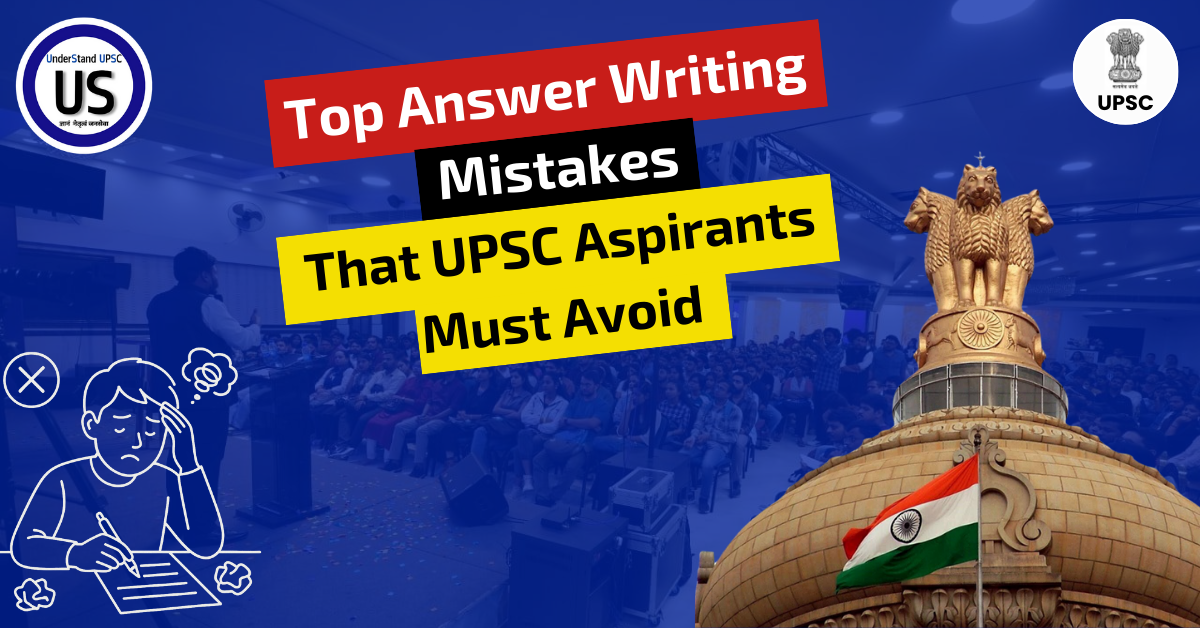
UPSC mains answer writing tips are essential for scoring well in the exam. Most aspirants focus heavily on content, but how you present that content matters just as much. In this blog, we’ll explore the top answer writing mistakes that UPSC aspirants must avoid that hold aspirants back—and how to avoid them. With guidance from mentors like Satyam Jain Sir and the expert team at UnderStand UPSC, you’ll learn to write answers that stand out.
1. Ignoring Directive Words
One of the most common mistakes is not paying attention to what the question actually asks. UPSC mains answer writing tips always start with understanding the directive words—like analyse, discuss, critically evaluate, or elucidate. These words tell you how to structure your answer.
- If it says “critically evaluate,” list positives and negatives.
- If it says “discuss,” lay out pros and cons logically.
- For “analyse,” focus on causes, effects, and deeper understanding.
👉 Tip: Circle directive words first while reading question, then draft a quick outline. That’s a key point in UPSC mains answer writing tips.
2. Poor Structure: No Intro, Body, Conclusion
Without a clear structure, even good ideas get lost. A strong answer follows:
- Introduction – Define or frame the issue.
- Body – Break into subheadings, use bullet points.
- Conclusion – Summarize key takeaways and suggest a hopeful way forward.
UPSC mains answer writing tips often emphasize this structure. Using headings like Background, Current Scenario, Challenges, and Recommendations makes answers much clearer.
3. Overwriting or Underwriting
A major mistake: either writing too little or too much. All UPSC mains answer writing tips warn against:
- Going off-topic to fill space.
- Stretching same things unnecessarily
Aim for 120-150 for 10-mark questions. Use bullets and sub-points to stay precise and rich in content.
4. Neglecting Current Affairs & Examples
Pure theory doesn’t score well. UPSC mains answer writing tips stress integrating:
- Data (e.g., Economic Survey, NITI Aayog)
- Policies (e.g., Digital India, Swachh Bharat)
- Real-world examples, anecdotes or recent news, etc
This shows you’re connected to the daily What’s happening in India? and not just memorising static text.
5. No Balance or Perspectives
UPSC loves balanced answers. Avoid writing one-sided views. Instead, present multiple perspectives:
- Domestic + international angle
- Benefits + drawbacks
- Government + stakeholder viewpoints
Frame like: “On one hand… On the other hand…”. This aligns well with UPSC mains answer writing tips and shows depth.
6. Ignoring Word Limit & Time Pressure
Time management is crucial. Allocate:
- 7 minutes for 10 marks
- 10 minutes for 15 marks
Practice writing full papers under timed conditions. Learn pacing and stick to UPSC mains answer writing tips about time limits.
7. Lack of Revision & Self-Evaluation
Writing practice alone isn’t enough. You must:
- Review your answers thoroughly
- Compare with model answers and toppers copies
- Spot recurring mistakes & try to address them in every subsequent mock test
UPSC mains answer writing tips always include reviewing and improving based on feedback from mentors like Satyam Jain Sir at UnderStand UPSC.
8. Bad Presentation & Handwriting
Even the best content falls flat if poorly written. To improve presentation:
- Use legible handwriting
- Leave margins, and maintain proper gaps between lines
- Highlight keywords or headings
- Include a quick diagram or flowchart and maps if relevant
Neat, well-presented answers reflect care and professionalism—aligned with UPSC mains answer writing tips.
9. Not Practicing Diagram Integration
If a question asks for steps/processes, use diagrams or flowcharts. Well-drawn visuals make answers shine. Integrate them whenever relevant to follow UPSC mains answer writing tips.
10. Using Unsubstantiated Claims
Avoid vague phrases like “India is developing rapidly.” Instead, support claims with numbers or policies:
- “As per Economic Survey 2024-25, India’s GDP grew by 7.5%…”
This level of clarity and backing is essential in UPSC mains answer writing tips.
11. Not Underlining or Highlighting Keywords
Underlining directive words or key phrases helps the examiner quickly see your alignment with the question. This simple step is often overlooked in mainstream answer writing.
12. Repetitive Content or Irrelevance
Avoid repeating points or adding off-topic material. Keep answers sharp with relevant content, as emphasised in UPSC mains answer writing tips.
13. Missing the Conclusion
Every answer must finish with a conclusion. Even a single line can provide closure, such as:
“Thus, while green energy has challenges, its benefits for climate and employment make it India’s future.”
14. Ignoring Feedback
Mentors like Satyam Jain Sir at UnderStand UPSC often say: “Feedback is your mirror.” Whether from peer review or test series, use feedback to refine structure, content, and presentation.
Bringing It All Together: Sample Skeleton
Let’s apply these tips in a model outline:
Q: Critically evaluate India’s renewable energy push and suggest improvements.
- Intro: Define renewable energy; contextualize with India’s targets (e.g., 450 GW by 2030).
- Body:
- Achievements: Solar, wind, government schemes.
- Challenges: Grid stability, cost, land use.
- Perspectives: Environmental vs economic; rural vs urban.
- Conclusion: Summarize and suggest balanced improvements.
This skeleton follows UPSC mains answer writing tips on structure, balance, examples, and conclusion.
How “Understand UPSC” Helps You Avoid Mistakes
At UnderStand UPSC, we combine curated content with real-time feedback to reinforce UPSC mains answer writing tips:
- Mock answer review from mentors like Satyam Jain Sir
- Interactive sessions highlighting mistakes like ignoring keywords or overwriting
- Flowchart workshops on neat diagrammatic responses
Explore more at https://www.understandupsc.com to see how we guide you on structure, balance, and academic rigors.
Quick Reference: UPSC Mains Answer Writing Tips Checklist
| Mistake | Tip |
| Ignoring directive word | Circle and obey it |
| Weak intro/body/conclusion | Stick to I-B-C |
| Overwriting or going off-topic | 150–250 words |
| No current-affairs support | Add data or schemes |
| Missing perspectives | Use balanced view |
| Ignoring time | Practice timed papers |
| No review | Regularly refine answers |
| Bad handwriting | Write neat and highlight points |
| Forgetting diagrams | Use visuals when needed |
| Unsupported claims | Always back with facts |
| No keyword underlining | Helps examiner navigate |
| Repetition | Avoid redundancy |
| No conclusion | Always end gracefully |
| Ignoring feedback | Incorporate mentor advice |
Final Thoughts
Mastering UPSC mains answer writing tips is less about knowledge and more about presentation, structure, and relevance. By avoiding key mistakes and implementing the strategies highlighted above, you ensure your hard work reflects in your scorecard.
Remember:
- Focus on directive words
- Maintain clarity through structure
- Back answers with current affairs
- Keep it balanced and to the point
- Always revise, refine, and seek feedback
These principles are at the core of UPSC mains answer writing tips that toppers swear by. With consistent practice and guidance from Satyam Jain Sir and the team at UnderStand UPSC, you’ll be on the path to writing high-quality, examiner-friendly answers. Want a free mock review session or more UPSC mains answer writing tips? Visit us at UnderStand UPSC and escalate your writing game today!




